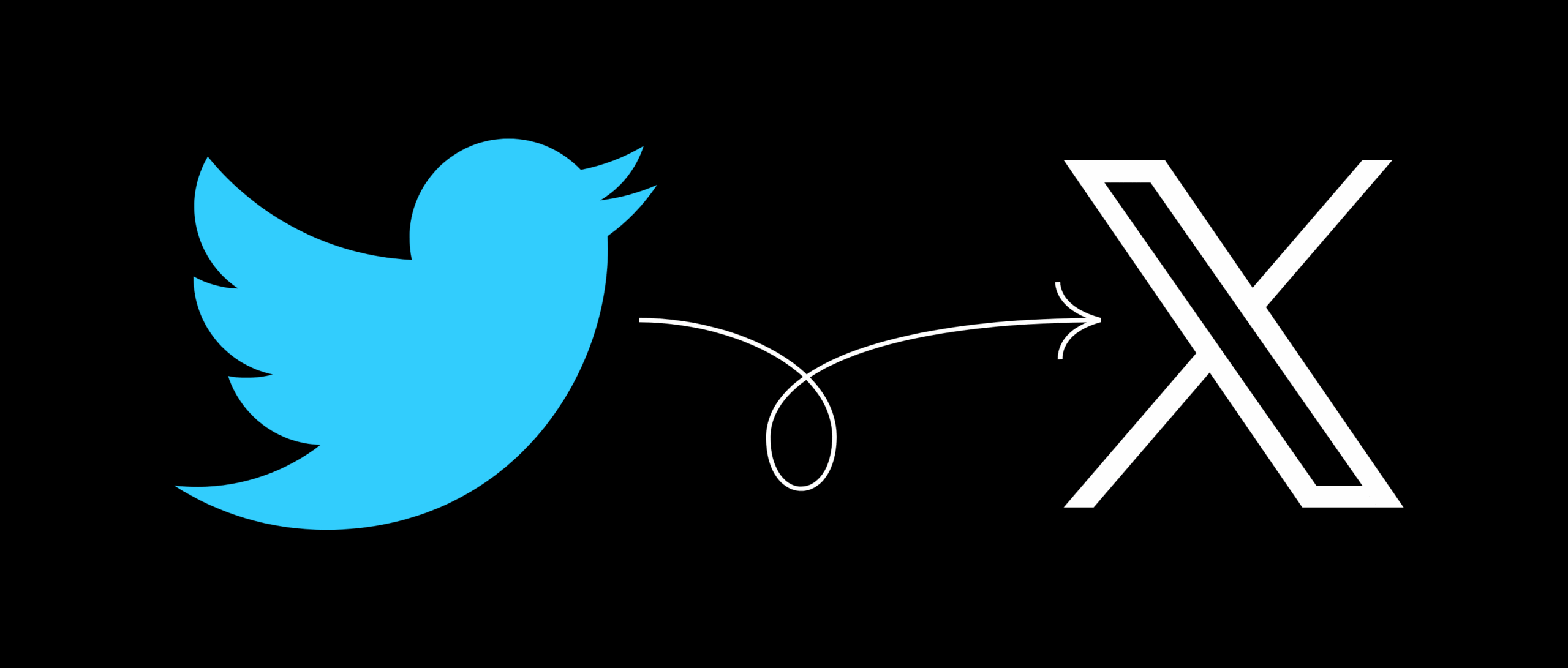When Elon Musk bought Twitter in October 2022, everyone expected change. But few expected one of the most iconic brands in the world to vanish overnight.
Twitter’s transformation into X wasn’t just a rebrand – it was a complete identity overhaul. In just one day, the beloved blue bird was gone, replaced with a bold new “X.” Tweets became Xs. The familiar light blue theme was switched to black.
It wasn’t just a new look. It was a message. But what was that message? And did people understand it?
A Storm of Change – The Timeline of Twitter’s Transformation
To understand how we arrived at this point, here’s how Twitter changed under Elon Musk’s leadership:
Key Management Shifts:
- October 2022: Elon Musk officially acquires Twitter for $44 billion, fires top executives, and starts massive layoffs.
- April 2023: Twitter is merged into X Corp, no longer functioning as a standalone public company.
- May 2023: Musk brings in Linda Yaccarino as CEO to handle advertising and partnerships, while he focuses on the product.
Major Product Changes:
- Dec 2022: Launch of Twitter Blue, a paid subscription model with verification and feature access.
- Jan 2023: Twitter replaces the Home timeline with a For You timeline.
- April 2023: The Twitter logo temporarily becomes Dogecoin’s Shiba Inu, sparking memes and confusion.
- May 2023: Users gain access to long-form content, video, and subscription monetization.
- July 3, 2023: A temporary daily tweet limit is introduced.
- July 28, 2023: Default mode turns to dark theme (light mode remains an option).
Brand Overhaul:
-
- July 23, 2023: Elon Musk runs a poll and changes Twitter’s color scheme to black.
Change default platform color to black
— Elon Musk (@elonmusk) July 23, 2023
- Later that day: He hints at a rebrand.
If a good enough X logo is posted tonight, we’ll make go live worldwide tomorrow
— Elon Musk (@elonmusk) July 23, 2023
And soon we shall bid adieu to the twitter brand and, gradually, all the birds
— Elon Musk (@elonmusk) July 23, 2023
- Still the same day: Twitter is rebranded to X. The bird is gone. The app, the logo, the brand – all changed.
A Shock to the System
This rebrand wasn’t gradual. There were no teasers, no big campaigns. The bird was just gone, replaced with an X.
— Elon Musk (@elonmusk) July 23, 2023
People were stunned. Some were amused. Many were angry or confused. Social media exploded with memes, jokes, and disbelief. Some likened the new logo to adult sites or gaming brands. Others mourned the loss of a cultural icon. “Killing the bird,” many said, felt like killing what made Twitter, Twitter.
Even more confusing, the rollout wasn’t smooth. While the logo and name changed, parts of the old Twitter branding remained on the website and app, leading to even more disorientation for users.
What They Risked – And What They May Have Lost
For years, Twitter wasn’t just another tech company — it was a living part of the internet’s culture. The blue bird was more than a logo. It was an icon that stood for real-time conversation, breaking news, activism, humor, and human connection. Words like “tweet” and “retweet” didn’t need explanation — they had become part of global vocabulary. The chirping notification sound was instantly recognizable, like a digital heartbeat for millions of users.
Then, overnight, it was all gone.
Elon Musk’s decision to replace Twitter with “X” wasn’t just a visual change. It was the dismantling of a brand that had taken over 17 years to build — one that had cultural equity far beyond most tech platforms.
According to industry analysts, the brand equity Twitter had built was worth anywhere from $4 to $20 billion. This wasn’t just about logos and names — it was about emotional loyalty. Users didn’t just use Twitter. They trusted it. They were proud to be part of it.
So why take the risk?
For Musk, this was about more than branding. It was about direction. “X” represented the beginning of a new era — one where the app wouldn’t just be for sharing thoughts, but for everything. Payments. Messaging. Shopping. Entertainment. A vision inspired by platforms like WeChat in China, Musk’s dream of an “everything app” required a clean break from the past.
And from that perspective, the rebrand worked in some ways:
- It immediately grabbed global attention.
- It drowned out the buzz around Meta’s Threads launch.
- It made it clear: something radically different was coming.
But the costs are impossible to ignore:
- Years of familiarity and brand recognition disappeared overnight.
- The emotional connection users had with Twitter was severed.
- People didn’t feel like they were logging into something new — they felt like something was taken from them.
- The user experience suddenly felt unfamiliar, fragmented, and for many, uncomfortable.
In branding, consistency builds trust. And when a brand breaks that consistency without preparing its audience, trust becomes difficult to regain.
Elon Musk’s Vision – What Is X?
Elon Musk has had a dream for years. Long before Twitter, he owned a domain: X.com. He envisioned a digital finance super-platform, like China’s WeChat, that could handle everything from messaging to payments.
Buying Twitter is an accelerant to creating X, the everything app
— Elon Musk (@elonmusk) October 4, 2022
Now, that dream is alive again. Musk claims Twitter’s old name didn’t reflect his ambitions anymore. The company is no longer just a place for micro-blogging. It’s evolving into X – a platform for video, voice, shopping, banking, and more.
CEO Linda Yaccarino supported the shift. In her words, X would become “the future state of unlimited interactivity.” Bold words. But users were left wondering: where is this future?
So far, we’ve seen a logo, a new color scheme, and a lot of tweets (or rather, Xs) – but not much functionality to back up the transformation.
Chapter 5: The Challenges Ahead
Rebranding Twitter to “X” might have been bold, but now comes the harder part: delivering on the promise.
From the beginning, the transformation felt fast and reactive. The logo change happened almost overnight. Strategic research, focus groups, and customer listening appeared to take a backseat to Elon Musk’s vision and Twitter polls. For a brand of this scale, that’s a risky move.
And while the vision of X as an “everything app” sounds exciting, execution is still lacking. Today, the platform remains largely what Twitter was — with some added payment and creator tools — but nowhere near the all-in-one experience Musk has hinted at.
Here are the key challenges ahead for X:
1. Vision vs. Reality
The concept of a super app is powerful, but building one requires:
- Deep integration of services
- Strong partnerships
- Regulatory compliance
- Clear user need and trust
Right now, the app’s functions are disconnected, and users are unsure what to expect or where it’s headed.
2. Brand Equity Reset
Twitter built its identity over nearly two decades. From Arab Spring activism to viral memes, it had carved a space in world history. That equity — the memories, associations, and user trust — was largely erased with one rebrand.
Rebuilding something with equal cultural relevance is a massive challenge.
3. Falling User Loyalty
Many loyal users feel alienated. Creators, journalists, and activists who once called Twitter their home are now testing out Threads, BlueSky, or Mastodon. Without strong community engagement, X may lose the very people who gave Twitter its voice.
4. Brand-Linked Controversy
With Elon Musk being so closely associated with X, any personal controversy affects the brand directly. For many users and advertisers, this creates hesitation — and reputational risk.
5. Advertiser Confidence
Even before the rebrand, advertisers were pulling away due to concerns around content moderation and platform stability. Convincing them to return will take:
- Transparency
- Stability
- Long-term product planning
- Clear value propositions
6. Lean Internal Team
After multiple layoffs and leadership exits, X is running with a smaller internal team. Delivering a super app requires strong product, marketing, engineering, legal, and UX alignment. Without enough firepower and internal clarity, execution may falter.
Conclusion: Chaos or Masterplan?
The rebranding of Twitter to X is one of the boldest brand moves in modern history. But is it a masterstroke or a mess?
If Musk’s team can deliver on the vision of an integrated, engaging, future-facing super app, the world may look back at the death of the blue bird as the beginning of something revolutionary.
But if X fails to connect with users emotionally and functionally, it will go down as one of the costliest brand blunders ever made – a lesson in what happens when you forget why people loved your brand in the first place.
For now, all eyes are on X. Will it rise? Or will the bird come flying back?



Comments are closed